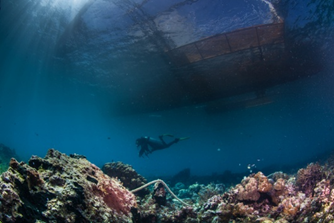Earth's oceans, spanning over 70% of our planet's surface, have always enticed humanity with their vastness and beauty, concealing mysteries waiting to be deciphered. From sunlit shallows to abyssal trenches, each layer unveils unique ecosystems and scientific puzzles.
The Sunlit Realm: A Bustling Marine Oasis
The journey into Earth's oceans begins in the sunlit zone, where sunlight penetrates to depths of about 200 meters. Here, an explosion of life thrives under the warmth and energy of the sun. Coral reefs dazzle with their vibrant colors, teeming with an astonishing diversity of marine creatures—from tiny plankton to majestic sea turtles and playful dolphins. These shallow waters are not only crucial for marine biodiversity but also provide essential resources for coastal communities worldwide.

The Twilight Zone: Shadows and Survival Strategies
Below the sunlit zone lies the twilight zone, spanning depths from 200 to 1,000 meters. Here, sunlight fades into darkness, challenging life to adapt. Bioluminescence illuminates this realm, showcasing creatures like the vampire squid and gulper eel, adapted to thrive in low-light conditions.

The Midnight Zone: Cold, Pressure, and Deep-sea Mysteries
Below 1,000 meters lies the midnight zone, where temperatures drop near freezing, and pressures can crush even the most robust of submarines. Yet, despite these harsh conditions, life persists in astonishing forms. Deep-sea vents and cold seeps create oases of life, fueled not by sunlight but by chemical energy from within the Earth's crust. Here, organisms such as tube worms and giant squid thrive, adapted to the darkness and extreme conditions of the deep.

The Abyssal Realm: Uncharted Depths and New Frontiers
Deeper still are the abyssal zones, home to trenches deeper than Mount Everest is tall. These regions, like the Mariana Trench, challenge our understanding of life's limits. Recent explorations have unveiled new fish species and resilient microbial communities thriving in seemingly inhospitable conditions.

Unlocking the Ocean's Secrets: The Role of Technology and Exploration
Advancements in technology, such as remotely operated vehicles (ROVs) and deep-sea submersibles, have revolutionized our ability to explore and study the ocean's depths. High-definition cameras, sonar mapping, and robotic arms enable scientists to collect samples, observe marine life, and map the ocean floor with unprecedented detail. These tools not only enhance our understanding of marine ecosystems but also provide insights into climate change, biodiversity conservation, and even potential resources for the future.

Conservation Challenges and Future Prospects
Despite their significance, oceans face threats like overfishing, pollution, and habitat destruction. Conservation efforts are essential to safeguard marine biodiversity and maintain sustainable ocean ecosystems. Continued technological innovation offers hope for better monitoring and protection of these invaluable natural habitats.
Conclusion
Earth's oceans remain a frontier of discovery, offering boundless opportunities for scientific exploration. From sunlit shallows to the abyssal depths, each layer reveals new wonders and challenges our understanding of life on Earth. By fostering exploration and conservation efforts, we can ensure these majestic realms continue to inspire and sustain life for generations to come.










